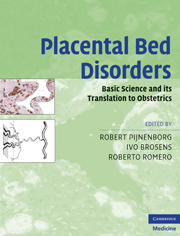Book contents
- Placental Bed Disorders
- Placental Bed Disorders
- Copyright page
- Dedication
- Contents
- Contributors
- Preface
- Section 1: Introducing the placental bed
- Section 2: Placental bed vascular disorders
- Section 3: Uterine vascular environment
- Section 4: Deep placentation
- Section 5: Comparative anatomy and research models
- Section 6: Genetics
- Section 7: Risk factors, predictors, and future management
- Chapter 19 The epidemiology of preeclampsia with focus on family data
- Chapter 20 Assisted reproductive technology and the risk of poor pregnancy outcome
- Chapter 21 Angiogenic factors and preeclampsia
- Section 8: Translation to obstetrics
- Index
Chapter 19 - The epidemiology of preeclampsia with focus on family data
from Section 7: - Risk factors, predictors, and future management
Published online by Cambridge University Press: 06 July 2010
- Placental Bed Disorders
- Placental Bed Disorders
- Copyright page
- Dedication
- Contents
- Contributors
- Preface
- Section 1: Introducing the placental bed
- Section 2: Placental bed vascular disorders
- Section 3: Uterine vascular environment
- Section 4: Deep placentation
- Section 5: Comparative anatomy and research models
- Section 6: Genetics
- Section 7: Risk factors, predictors, and future management
- Chapter 19 The epidemiology of preeclampsia with focus on family data
- Chapter 20 Assisted reproductive technology and the risk of poor pregnancy outcome
- Chapter 21 Angiogenic factors and preeclampsia
- Section 8: Translation to obstetrics
- Index
Summary
Keywords
- Type
- Chapter
- Information
- Placental Bed DisordersBasic Science and its Translation to Obstetrics, pp. 195 - 206Publisher: Cambridge University PressPrint publication year: 2010

